The Netherlands will be facing Nadeshiko Japan in the round of 16 of FIFA Women’s World Cup 2019.
Sarina Wiegman brought her side into the round of 16 perhaps with ease. Her side won all three matches, defeating the likes of New Zealand, Cameroon, and even Canada to top the table.
The same thing can’t really be said about Asako Takakura’s team. The Nadeshiko Japan only managed to edge themselves past the strong group D which contains teams like England, Argentina, and Scotland. With a win, a draw, and a loss in each of the three games they’ve played, Japan – who finished as runners-up in the last edition of the FIFA Women’s World Cup – are expected to do much better if they’re looking to down a strong Netherlands side.
This could potentially be an exciting clash, largely due to both team’s exciting style of play. We’ll take a closer look at how both teams will set themselves up in the match on Tuesday in this tactical preview.
Both team’s potential setup
Netherlands
The Netherlands have always played with the same 4-3-3 system since day one in this competition. Wiegman also seemed to prefer playing the same team throughout their campaign. The only changes in the starting lineup that we have seen so far were Anouk Dekker who has been starting ahead of Stefanie van der Gragt in the last two games and Merel van Dongen who played brilliantly the last time out as she replaced Kika van Es. It seems quite likely that we’re going to see a familiar setup again in the next game.
Predicted starting XI: van Veenendaal – van Lunteren, Dekker, Bloodworth, van Es – Spitse – Groenen, van de Donk – van de Sanden, Martens – Miedema
Japan
Just like the Netherlands, Japan have always played with the same setup in this tournament – a classic 4-4-2.
But unlike Wiegman, Takakura tended to make a small rotation in her squad in every game.
Predicted starting XI: Yamashita – Shimizu, Kumagai, Minami, Sameshima – Nakajima, Miura, Sugita, Hasegawa – Sugasawa, Iwabuchi
Netherlands’ attacking style of play analysis
Diagonal long passes from the back
Wiegman’s side plays out from the back quite a lot, but they always want to advance quickly. This is why we see a lot of long forward passes from behind, usually diagonally.
In the previous tactical preview of the Netherlands, we have mentioned that the players that are responsible for these passes are Bloodworth and Spitse. Both of them have extraordinary vision and are able to deliver perfectly-weighted, accurate passes almost all the time. Of course, to prevent these passes from happening, the opposing team should mark and press these two aggressively. If you give them time and space, they’ll deliver those passes.
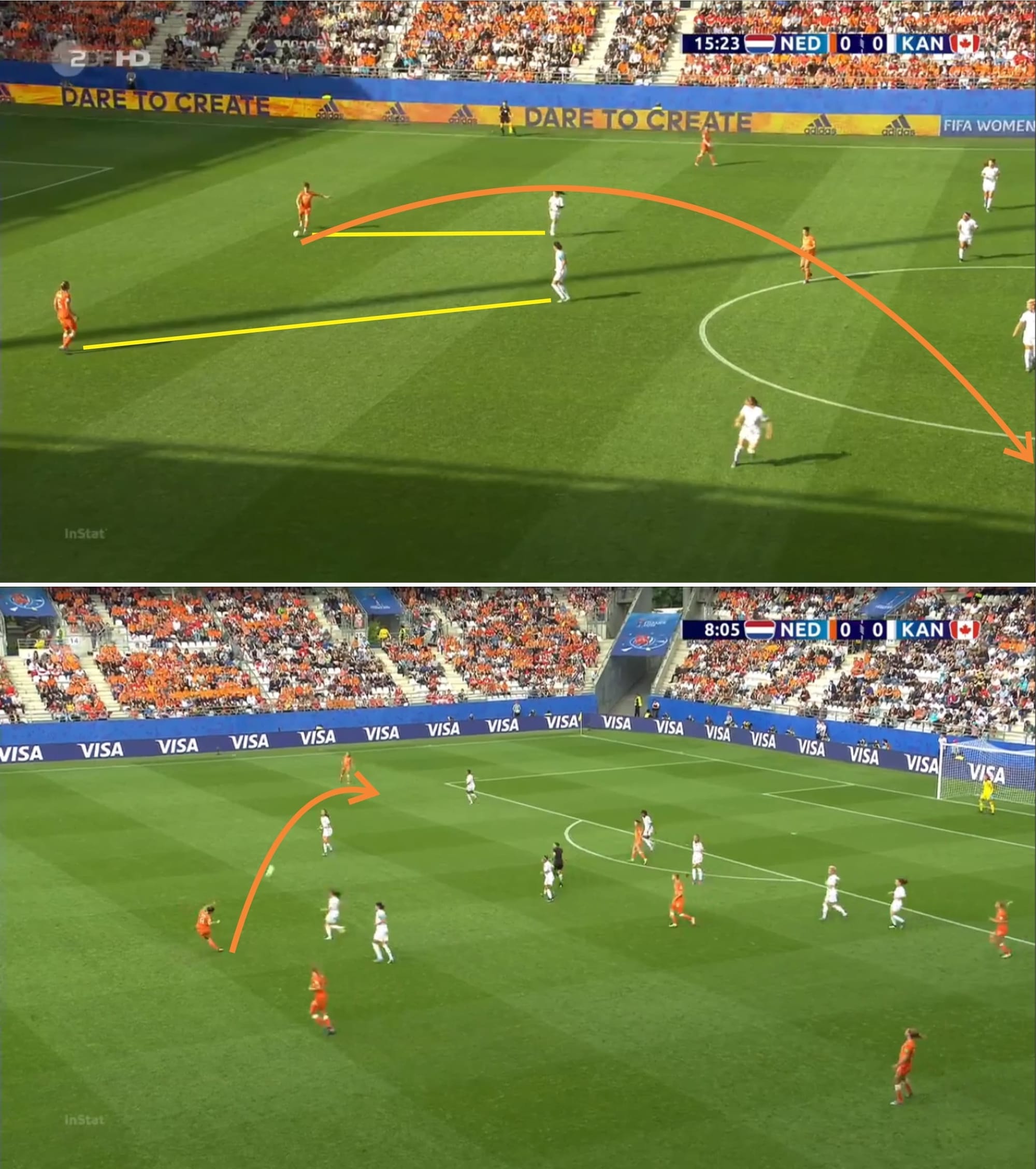
These two pictures provide an example. In the first one, we can see Canada defending with a mid-high block, but they didn’t press the centre-backs. Without the pressure, Bloodworth had complete freedom to distribute the ball wherever she wants.
In the second one, Spitse was completely free and the defending player was far too late to press her and prevent the diagonal pass.
These diagonal passes were extremely vital in the Netherlands’ attacking play as they always looked to break quickly from wider areas.
But what if the wide forwards are tightly marked? Will they still deliver these diagonal passes? To answer that, let’s move on to the team’s attacking shape.
Attacking shape
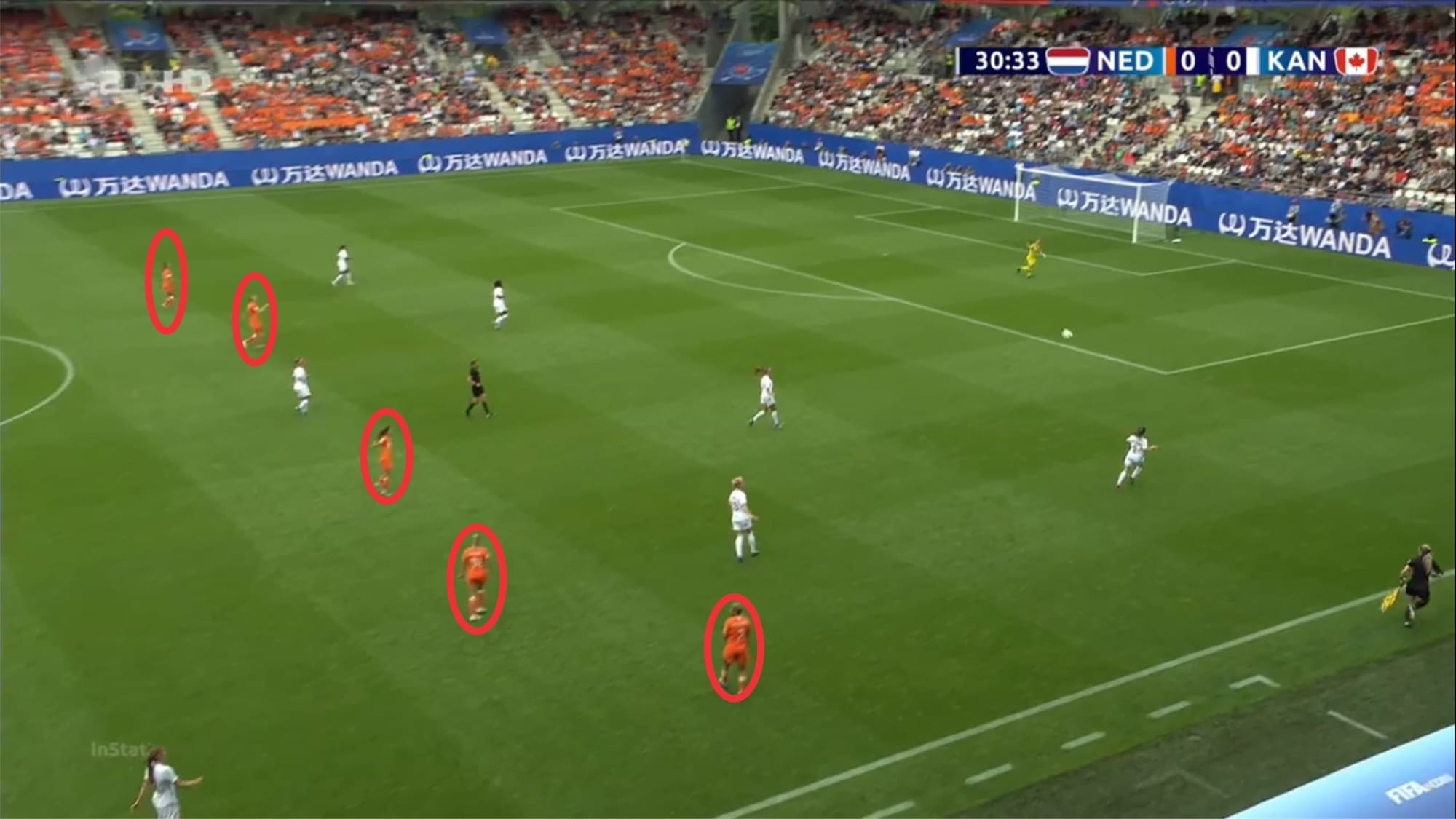
The Netherlands tend to take a 2-3-5 shape when in attack. This provides numerical superiority as they had to go against a four-player defence. With Groenen and van de Donk advancing forward and occupying the half-spaces, full-backs are often confused as to whether or not they should mark them. Often times the wingers are often able to free themselves up and exploit the spaces out wide due to this attacking overload.
Some other times, the opposing defensive/central midfielders will track back and try to mark Groenen/van de Donk. In that case, the distributors still have other options with the high full-backs.
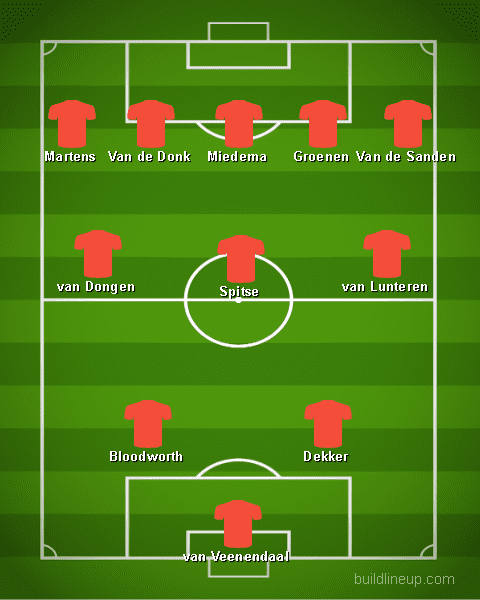
As the full-backs sit high up the pitch and the defending players are busy marking their players, these full-backs are often free out wide. That way, the Netherlands are still able to attack from the flanks without much trouble.
Exploit the flanks
The Netherlands’ main source of attacks is from the flanks. They love to play with width and they rotate the ball around the flanks a lot. With the full-backs sitting quite high, the centre-mid drifting wide, and the winger dropping deep – they are often able to open up spaces and attack the flanks with their passing and movements.
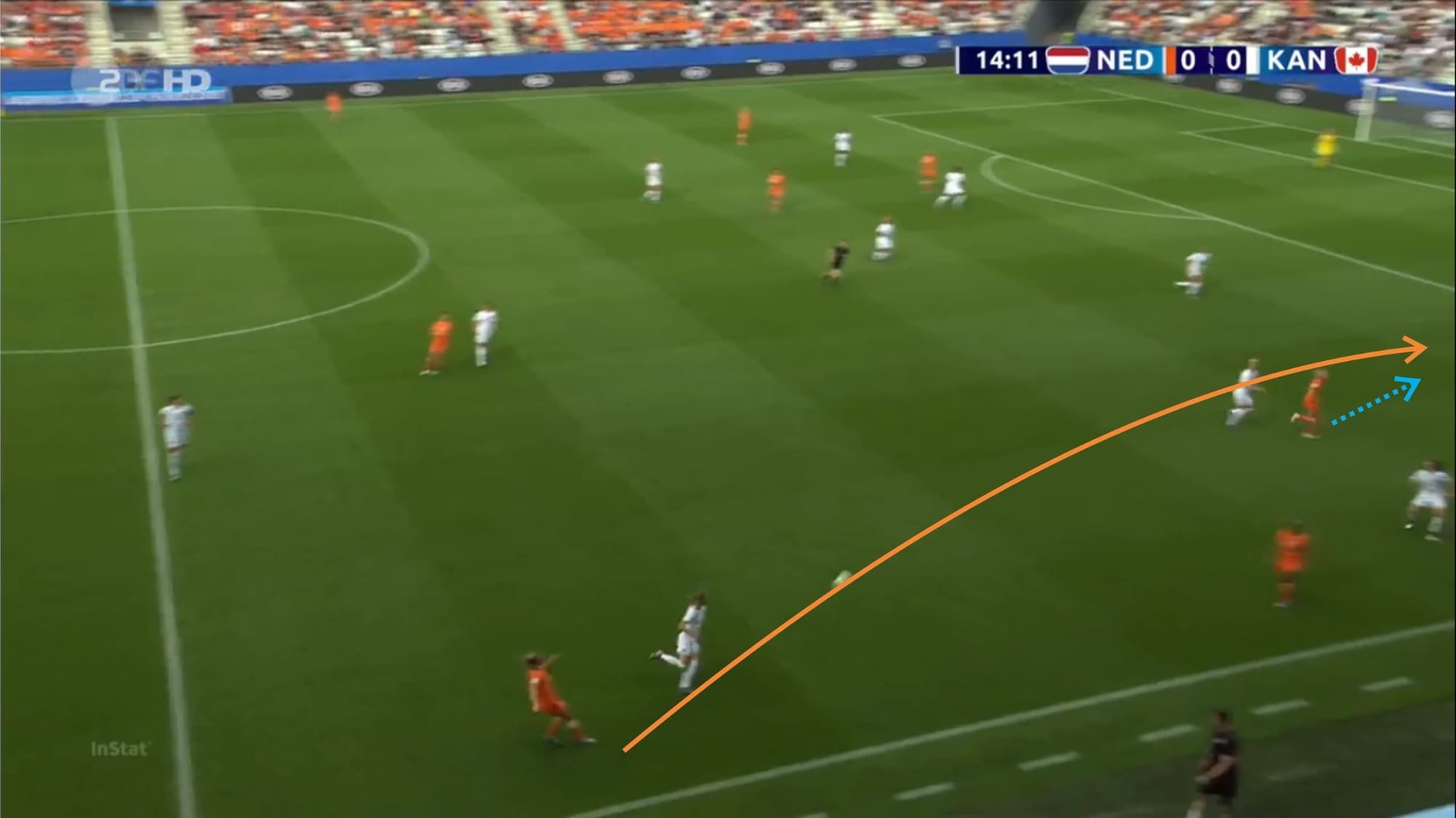
In the picture above we can see how they can attack the flanks with their passing and movements.
Van Lunteren had the ball with her and van de Sanden dropped deeper and moved closer to her. Her marker, Allysha Chapman, followed her and left some space on the left side of Canada’s defence. That was when Groenen took advantage and made the attacking run to exploit the space.
Situations like this happened numerous times in this game and they were certainly not easy to anticipate.
Sometimes the full-back decided not to follow the winger and stick to her position to prevent the centre-mid’s advancing run. This, of course, left the winger with massive space in wider areas.
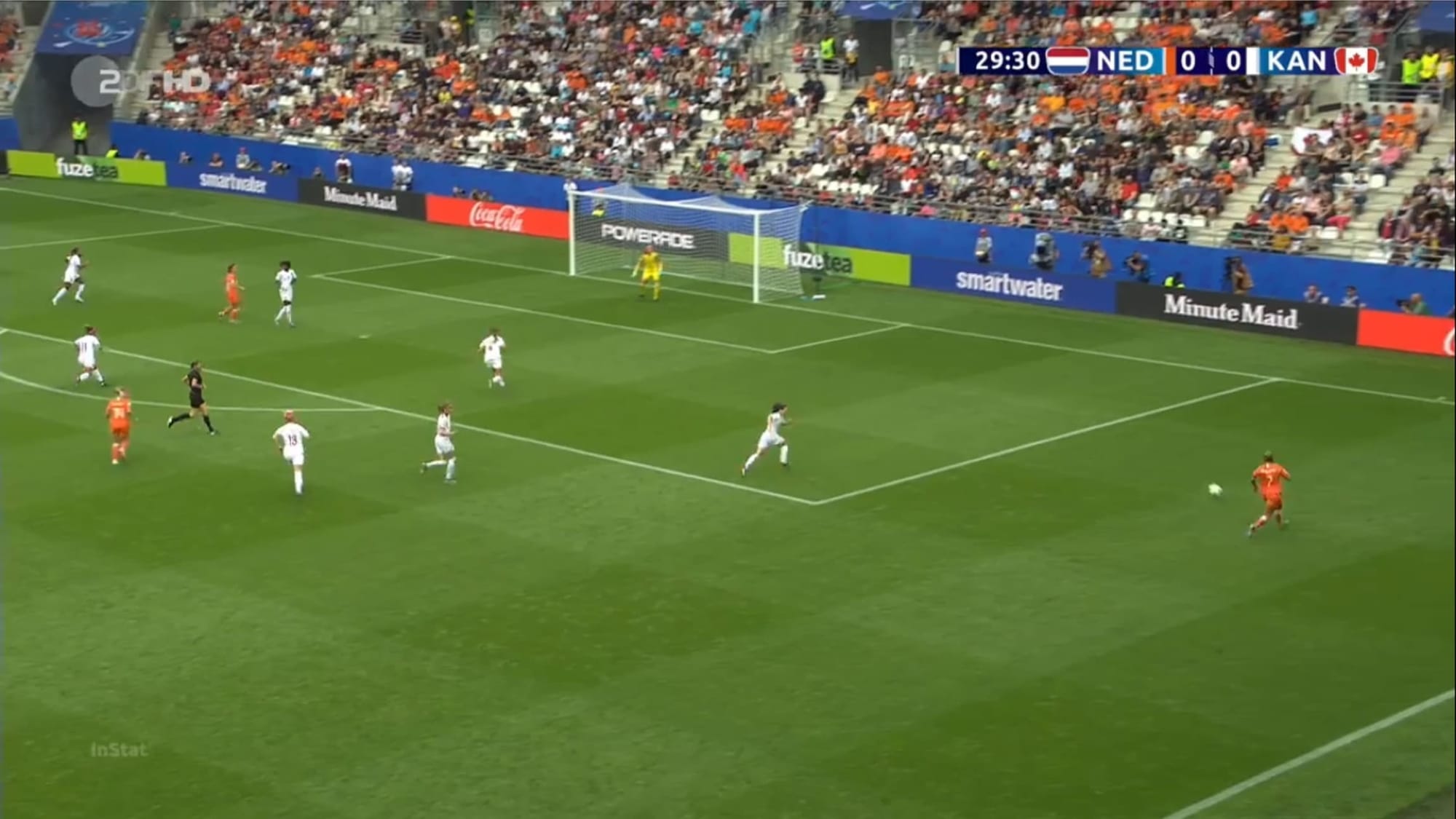
Netherlands’ quick breakaways
De Oranje Leeuwinnen seem to break quickly whenever they find gaps to exploit. And they are, of course, even more dangerous after winning possession.
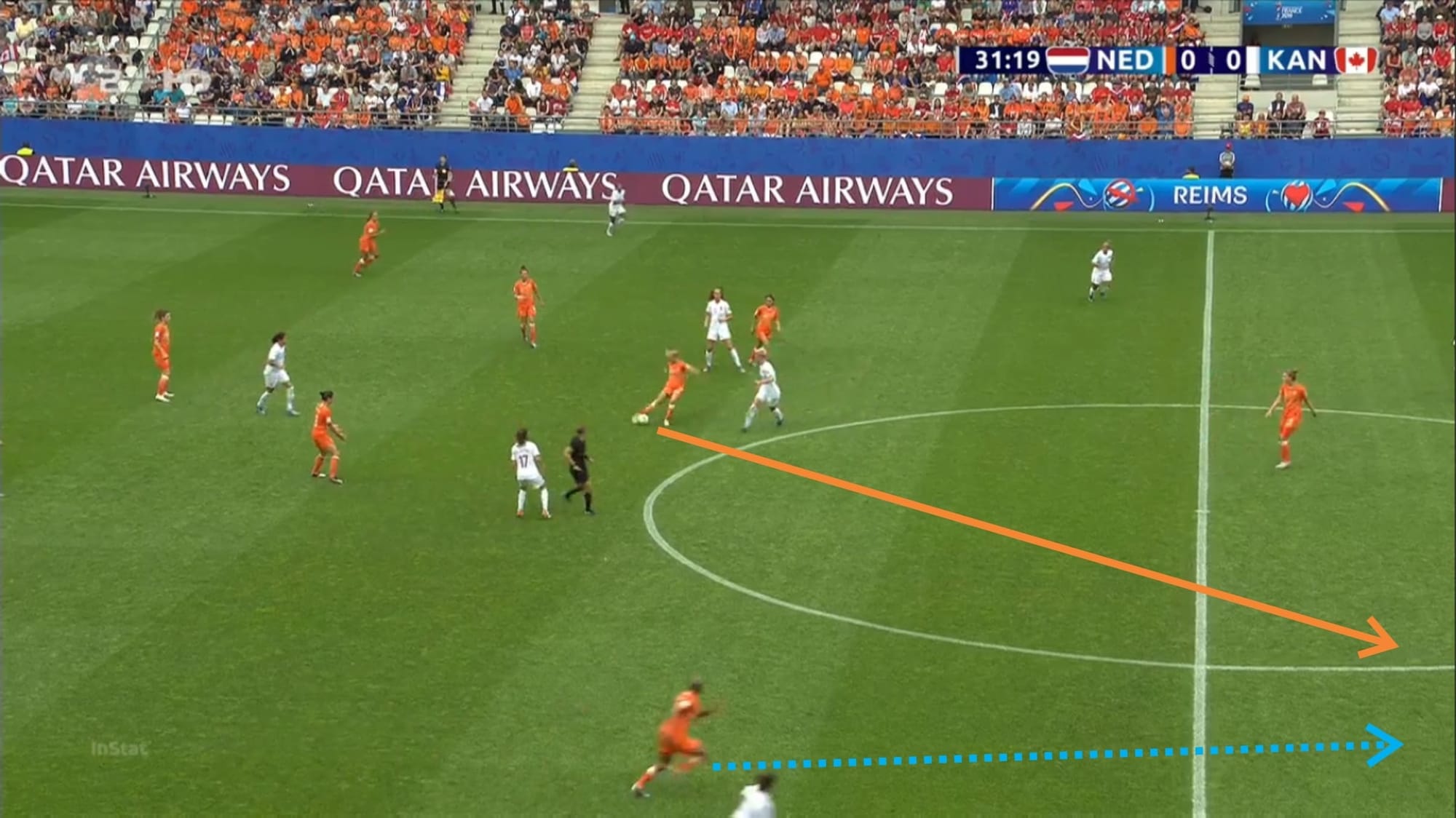
Here we can see Wiegman’s side trying to launch a quick counter immediately after winning possession in the middle of the pitch. The forwards are always ready to make a run and the passers seem to always know where to pick out these attackers.
The Netherlands love to catch the opposing team napping on the break but so do Japan. Both teams are extremely quick and dangerous on the counter, but the latter execute it differently. We will cover that later in this article.
Miedema’s positioning
In the last three matches, Miedema has no doubt been a crucial part up front. She plays a pivotal role in not just converting chances, but in disrupting and dismantling the defence. She does all of these with her positional play and movements.
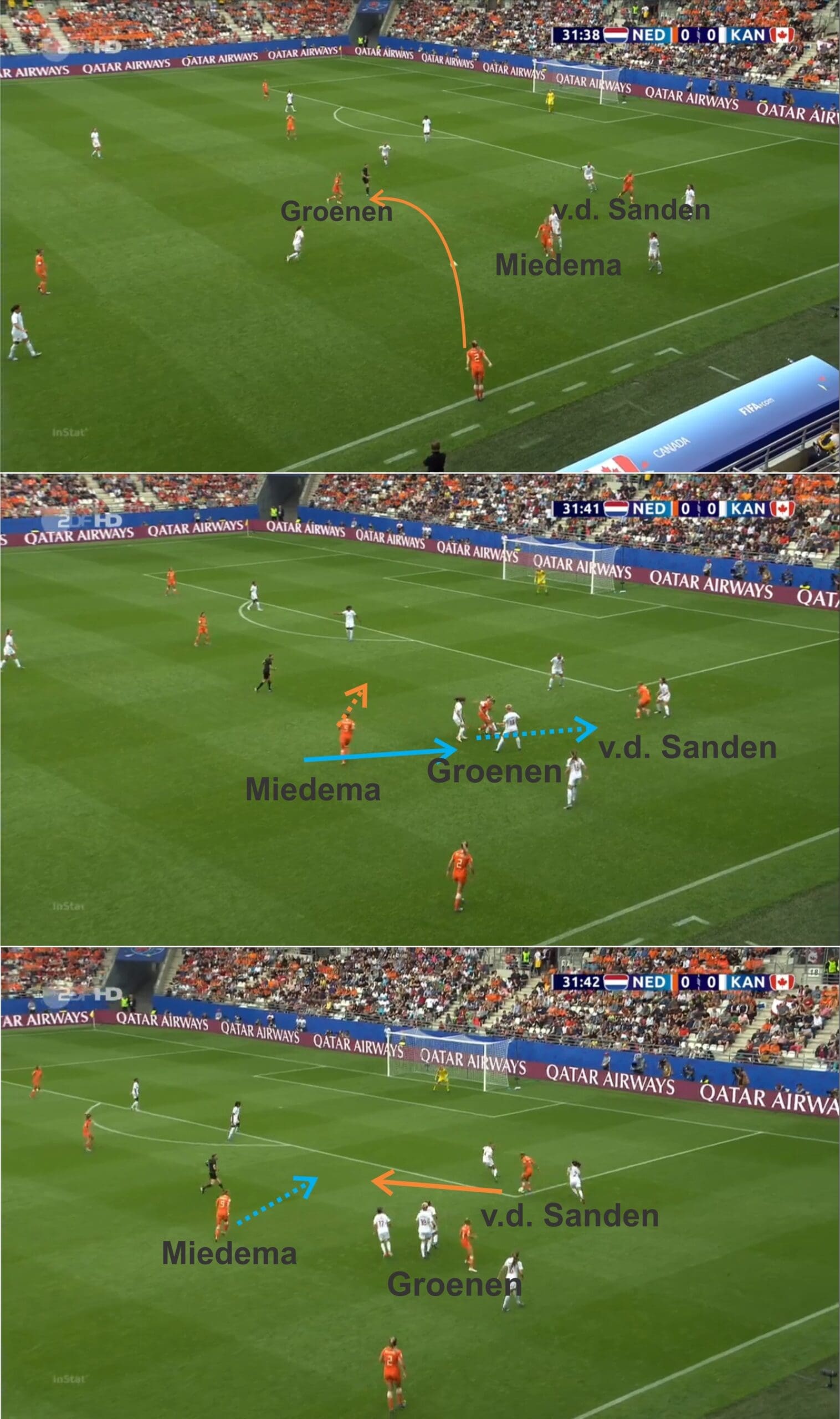
In here we can see the attacking process of Wiegman’s side. Miedema positioned herself deep and wide, drifting quite far from her designated spot. Van Lunteren gave the ball to Groenen, who in turn brought the ball forward. The latter then passed the ball to van de Sanden who delivered the ball onto the path of Miedema who was completely free. The Arsenal striker took a first-time shot which unfortunately flew high and wide off the goal. Despite that, this kind of movement was very promising and Japan should be aware of this kind of situation.
In this situation, Miedema was marked at first. But as Groenen dribbled the ball forward, she entered a pressing trap and Miedema’s marker left her to help the team press.
As you may also notice, Canada actually tried to swarm the ball-carrier in here, trying to press and isolate Groenen and mark van de Sanden. The attempt ended up in failure though, as the Dutch players managed to escape the pressure and take advantage of the disrupted defence.
Netherlands’ defending style of play analysis
The Netherlands blocked high as usual in their match against Canada. They pressed aggressively and tried to win the ball from as high up the pitch as possible. They tended to press immediately after losing possession and broke forward quickly after that.
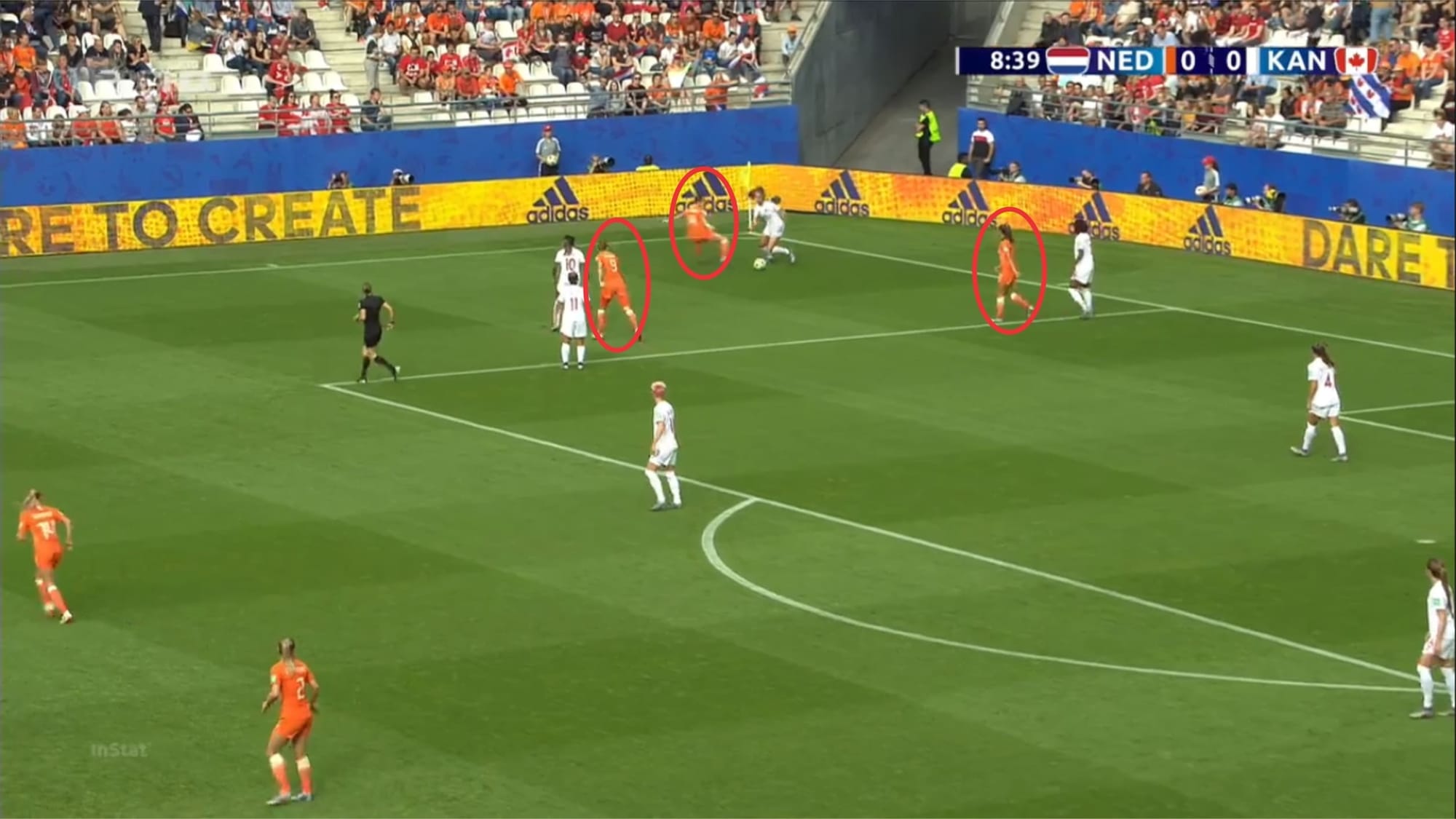
As we can see from the picture above, the Netherlands pressed Canada after losing the ball in wider areas up front. They immediately closed down the ball carrier and tried to isolate her and win the ball back with a player-oriented pressing.
Miedema played an important part in pressing as well, roaming out of position to help the team press. She also seemed to occasionally track back after a turnover to help the team defend.
Wiegman’s side seemed to also start overloading the flanks and isolating the ball carrier when the opposing team is playing wide. This was apparent in their match against Canada, but they didn’t seem to employ the same tactics against New Zealand and Cameroon previously.
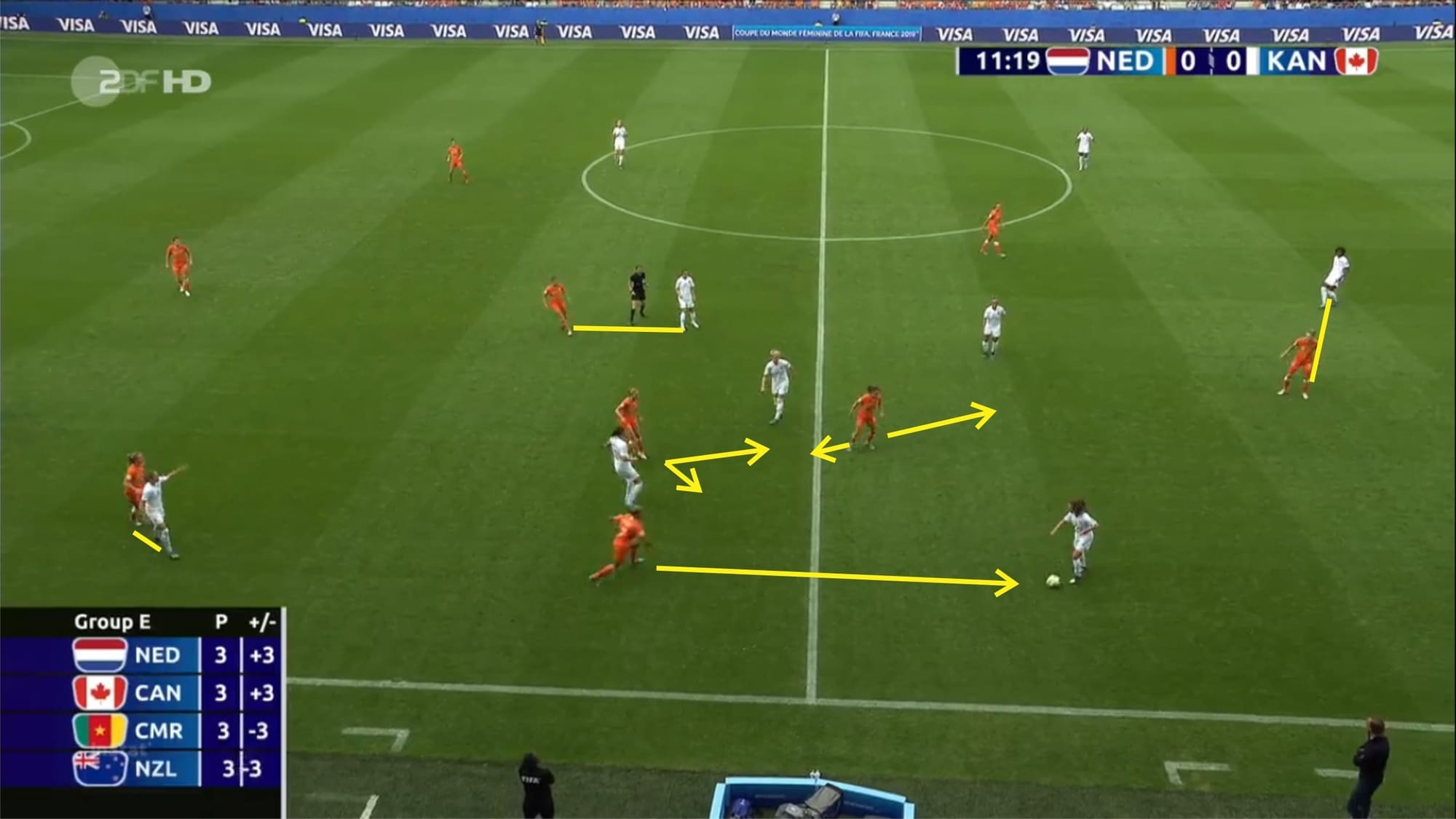
Due to this flank overload, Canada were having a difficult time trying to break down the defence from wider areas. As a result, they resorted to playing and trying to break through centrally.
The Dutch side tend to shift into a 4-14-1 shape when defending, forming two banks of four.
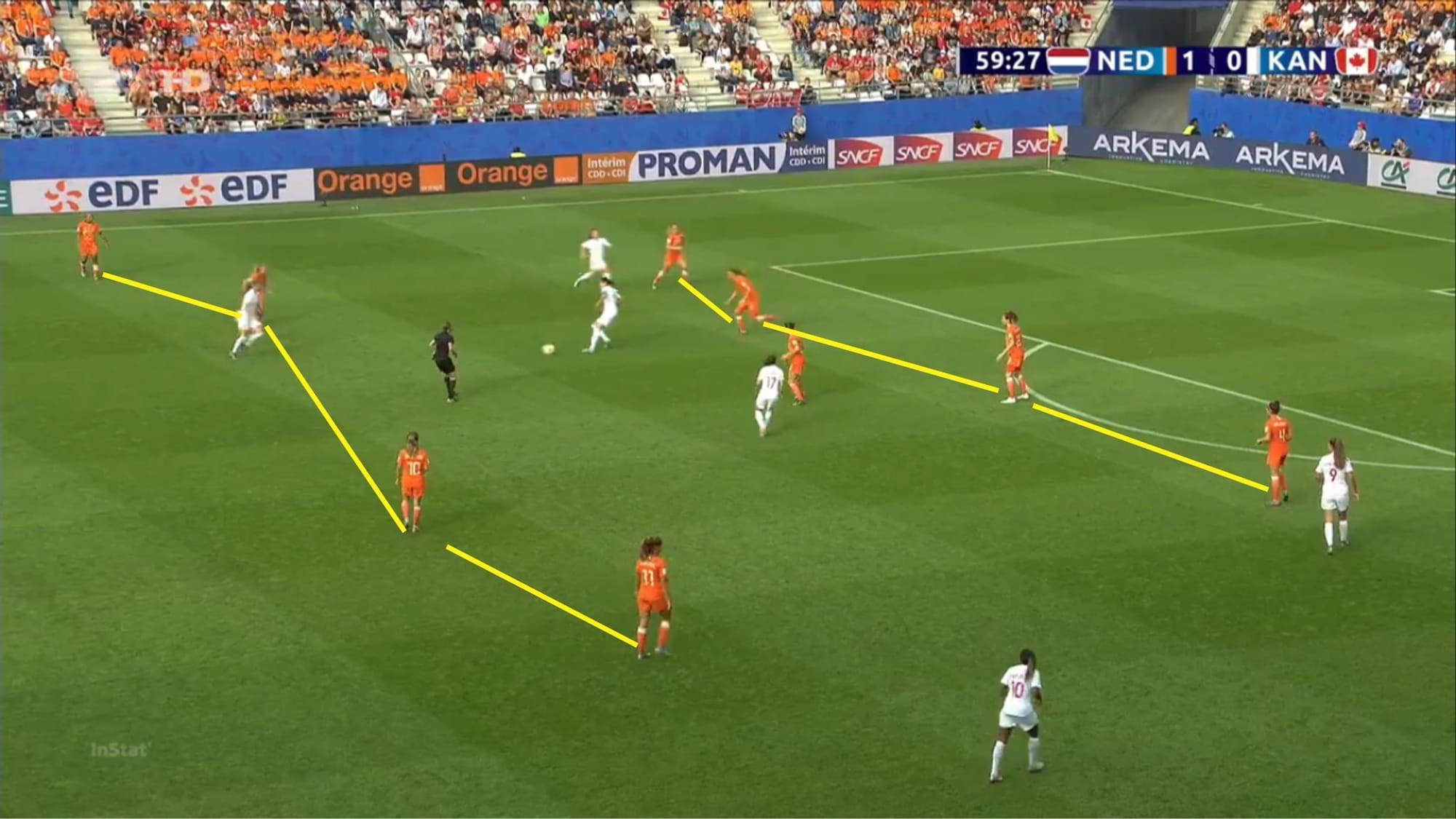
Combining zonal and player-oriented marking, the Netherlands’ wall of defence is quite hard to penetrate.
Netherlands’ weaknesses
Every team have at least one weak spot that the opposing team can exploit. The Netherlands in fact, have at least two.
First of all, they rely quite heavily on Bloodworth and Spitse when it comes to ball distribution from the back.
Dekker or van der Gragt is not really a ball-playing defender. Those two, while still quite proficient in delivering good passes, aren’t exactly built for ball-playing tasks. Instead, their job is limited to mostly defend due to their aggressive approach, physical strength, and defensive prowess. Bloodworth, on the opposite side, needs to work harder to improve her marking ability, but she has the ball deliveries and the touch of a midfield playmaker.
Meanwhile, Spitse is just very clearly the general in the midfield. Of course, it would make sense to give her absolutely no time and space at all to distribute passes. Her partners, van de Donk and Groenen, are more involved in the attack and will try to open up spaces up front by advancing forward. This leaves Spitse alone and fairly vulnerable in the centre of the field. Despite her intelligent positioning and game-reading as well as excellent ball retention, marking and pressing Spitse aggressively may just limit her threats considerably.
I’ve also mentioned in the previous two tactical previews (New Zealand vs Netherlands and Netherlands vs Cameroon) that overloading the flanks will give the Dutch a very hard time in attack.
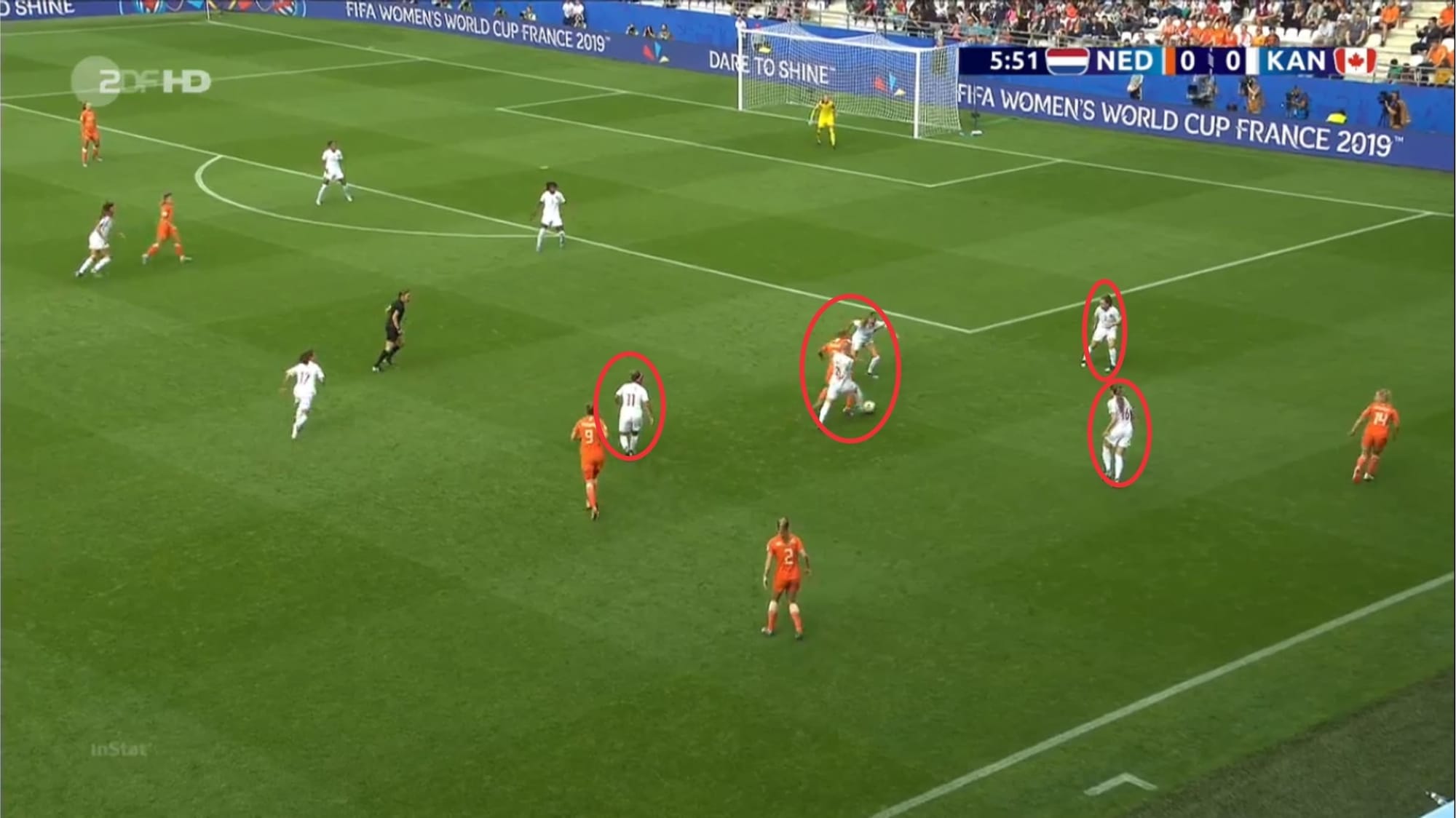
As we can see here, Canada were trying to swarm and isolate the ball carrier by overloading the flank. Though the Netherlands managed to escape these traps several times throughout the game, they were certainly struggling a lot in the process.
Japan’s attacking style of play analysis
As mentioned previously in this article, Japan tend to break forward quickly. Takakura’s side transition quickly from defence to attack and they are extra dangerous when regaining possession in the opposition half. But unlike the Netherlands, Japan favour short-medium range passes rather than longer ones. They also prefer delivering ground passes rather than lofting it forward. This is perhaps due to the players’ lack of physical strength and ability to win aerial duels.
Now let’s take a look at this picture below.
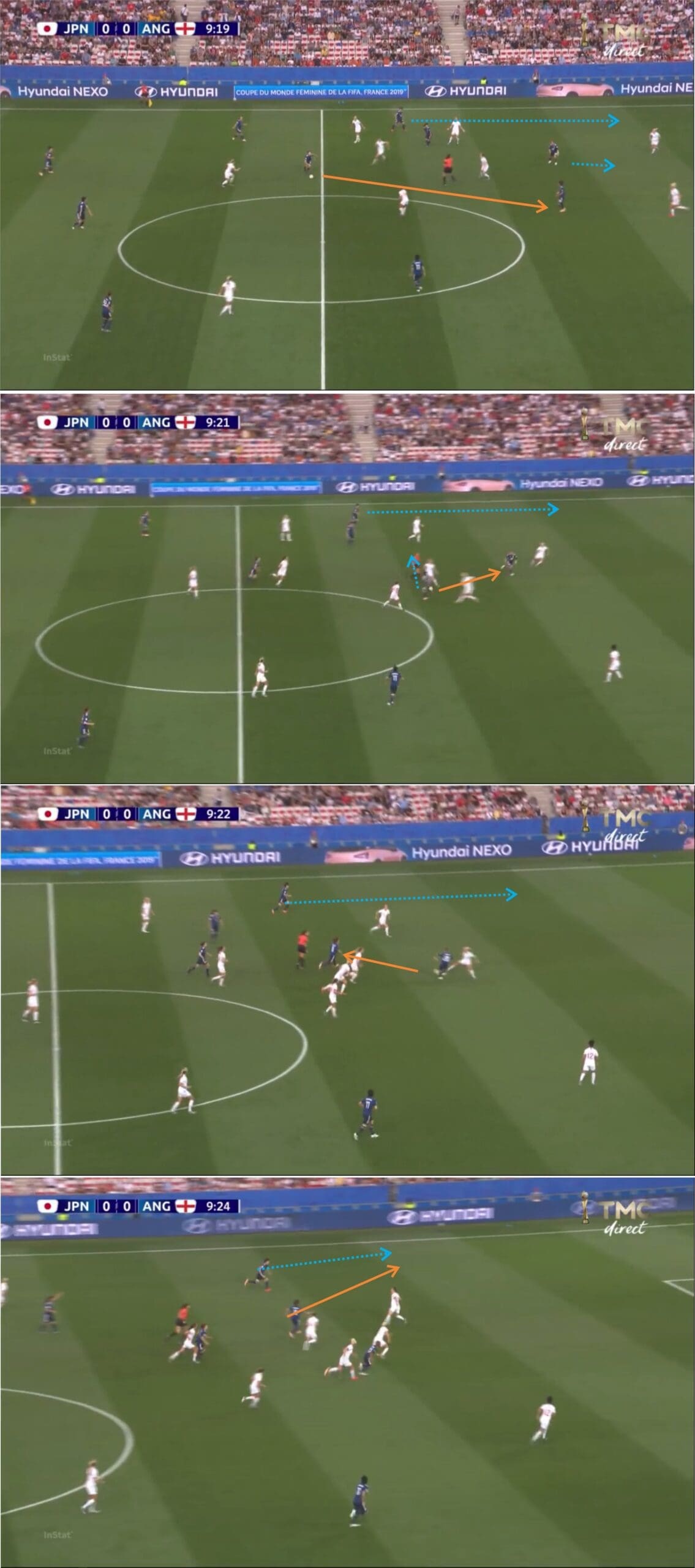
Here we can see Japan’s quick and straightforward build-up play. They prefer to play through the middle, progressing and breaking the defensive lines with quick one-two touch plays. They tend to move the ball vertically rather than laterally. Players are actively moving and looking for spaces and they always continue moving after touching/passing the ball.
Though sometimes they looked a bit too rushed, this kind of quick plays often catches the opposing team napping on the break.
Japan’s defending style of play analysis
Nadeshiko Japan defend with a high block and their shape is very compact and narrow. With this shape they can compress spaces in the central areas, forcing the opposing team to attack through wide areas instead.
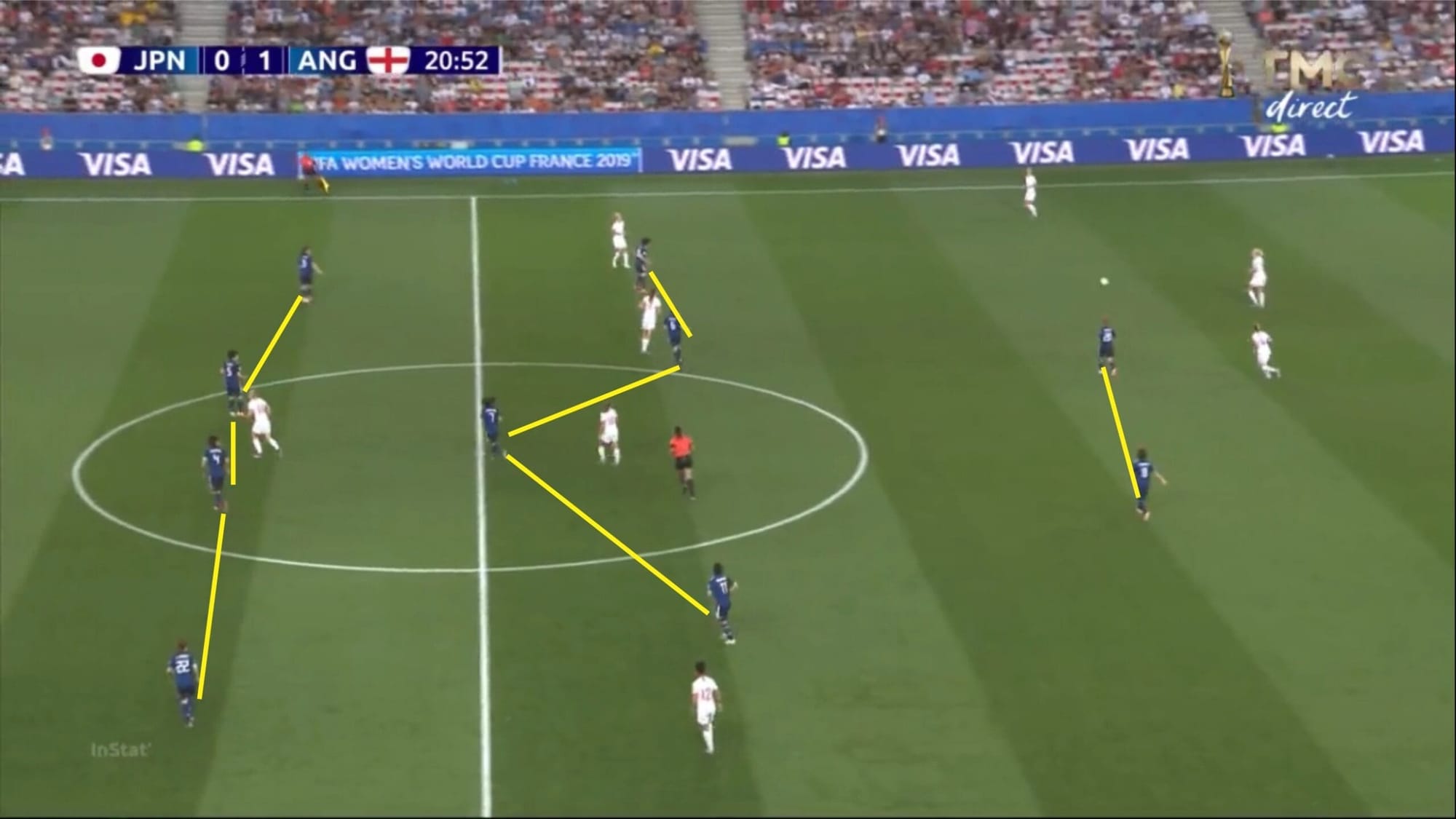
But, of course, for a team like the Netherlands who throw players forward in numbers and exploit flanks, this shouldn’t be a very serious problem.
In defence, Japan also tend to not press the centre-backs, allowing them to play with the ball as long as it’s still in the centre. If the ball is moved wider (via centre-back dribbling the ball or passing the ball to the full-back), they’ll trigger a pressing trap and quickly close down the wide player.
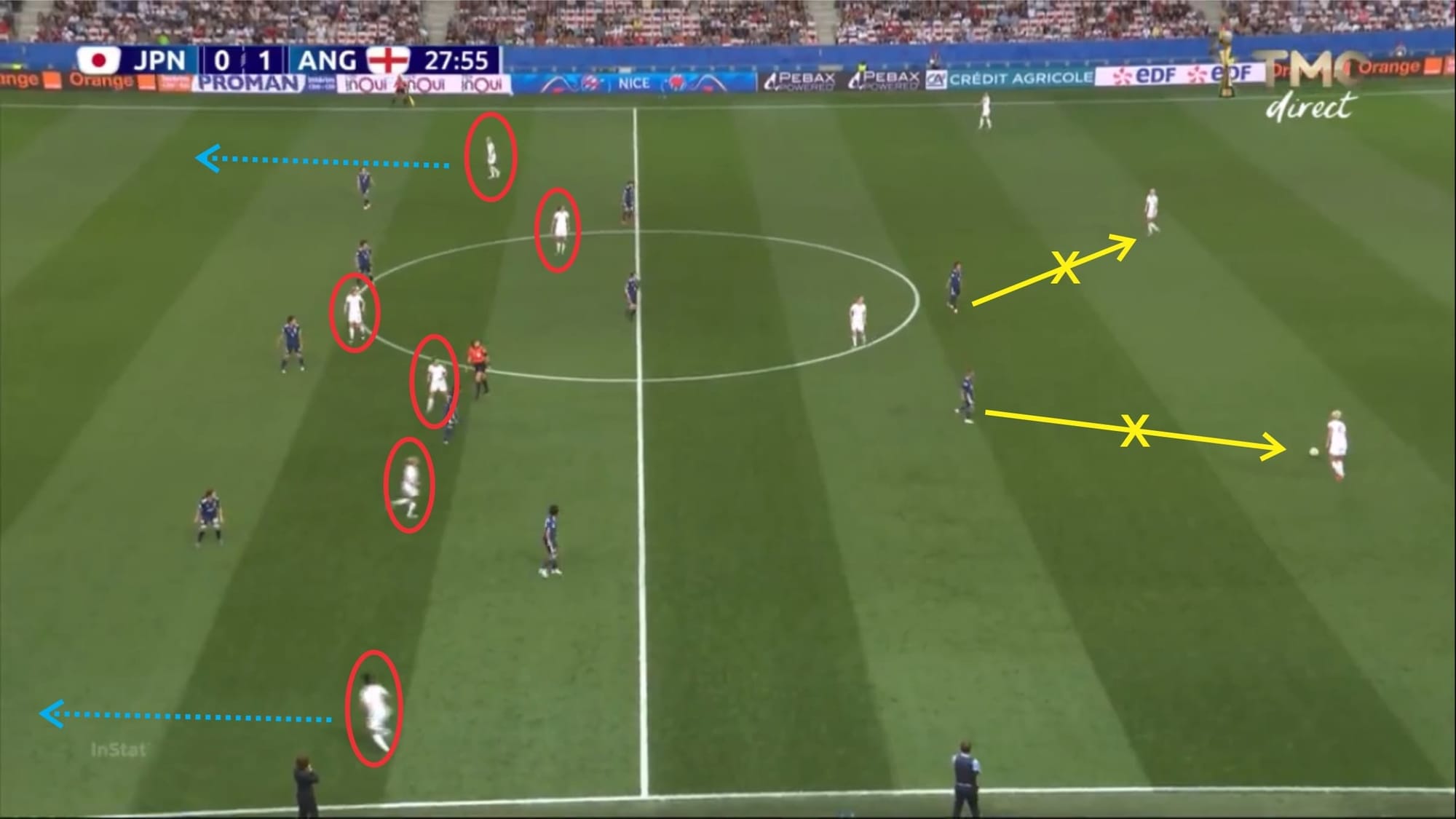
Despite their compact shape, strangely enough, England still seemed to be able to attack the central areas. As a matter of fact, their two goals against Japan were the result of central breakthroughs.
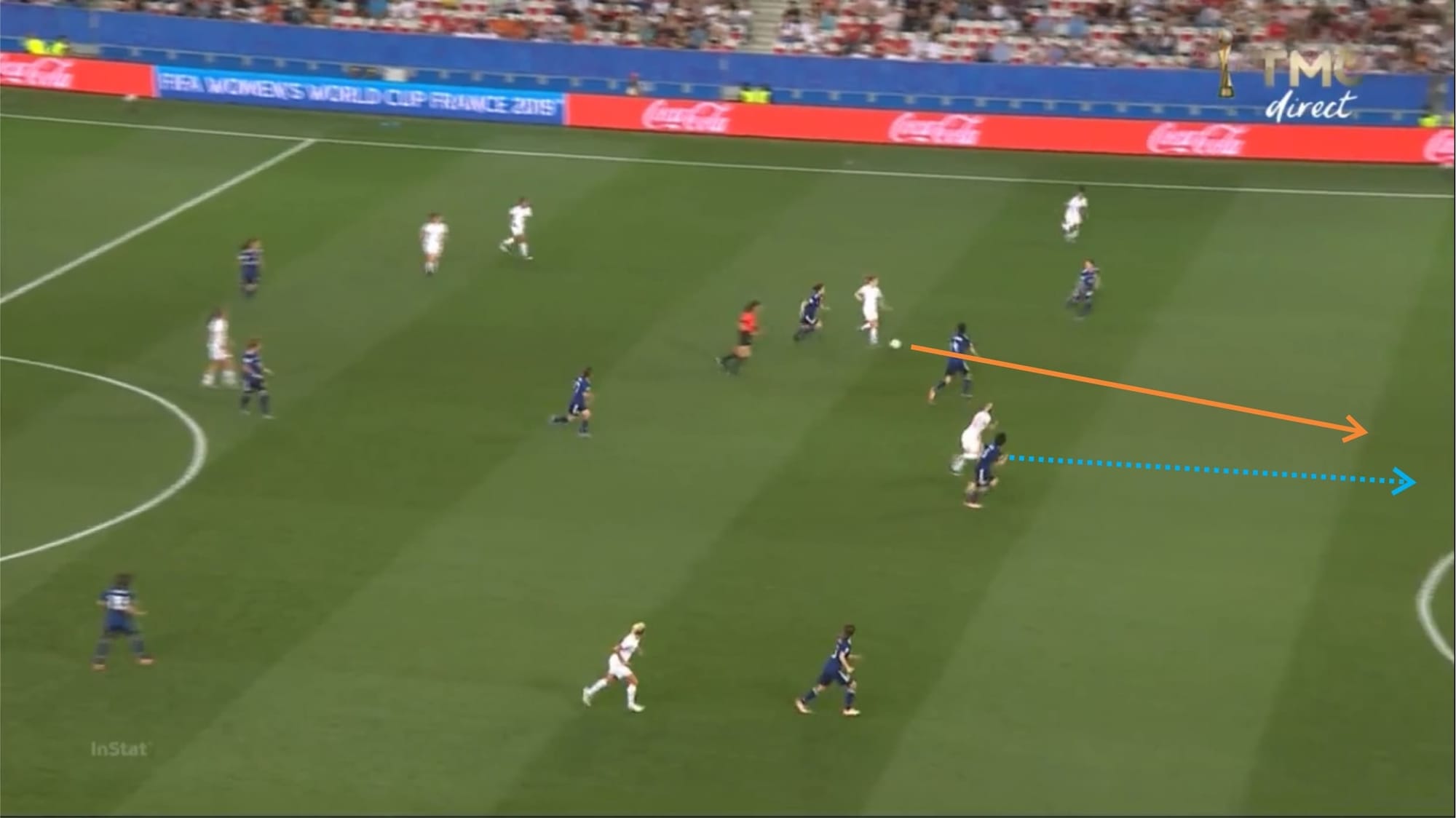
The picture above is the process of the second England goal which was a replica of the first one.
Karen Carney dribbled the ball past the midfielders and slotted it through to White who wins the race to the ball against Ichise and slid the ball into the bottom corner. You can also see in the picture, centre-back Kumagai rushing in but ultimately failing to intercept the ball.
The first goal was from the same scenario. Georgia Stanway brought the ball forward and muscled off the opposing midfielder. She delivered a pinpoint through pass which Kumagai failed to intercept. Ichise also failed to mark the striker and anticipate the attack. As a result, White was clean through on goal and only had the goalkeeper to beat.
Japan’s weaknesses
Japan have very quick, agile, and energetic players with great stamina. But if there’s one physical attribute that they’re lacking, it’s body strength. When playing against Scotland and England it seemed quite clear that this is their weak spot.
It also makes sense that they tinker their style of play to play quick exchanges of ground passes rather than lofted passes.
In their last three games, they averaged around 30 aerial duels per game, winning only 49% of them. They could be vulnerable to aerial balls into the box, which is actually the Netherlands’ strong point.
They also seemed to only hold the ball for a small amount of time before moving it again. This is perhaps to avoid getting challenged by the defending team as they seemed to get outmuscled most of the time in the midfield. Despite their technical proficiency and tactical intelligence as well as agility, they still seemed to struggle to retain the ball most of the time.
Relevant statistics
Netherlands
The Netherlands are known to attack mostly from the flanks, especially the left flank. But against Canada the last time out, their attacks came mostly from the right wing. According to the stats, a staggering 45 attacks actually came from the right side, 26 came from the left, and only 13 from the centre. This was perhaps due to Canada’s right-back Ashley Lawrence who defended brilliantly in that game, essentially killing the Dutch’s attempts to attack from the left.
De Oranje Leeuwinnen also had a 2.5 xG in their last game against Canada from eight shots (37.5% on target). That really shows that they do create lots of chances and some of them have a good chance of turning into a goal. Unfortunately, they’re just a bit wasteful in front of goal as they only managed to put two in past the goalkeeper. Despite that, the Netherlands are quite solid in defence, only conceding two goals from three matches.
Japan should also be careful of the Netherlands’ free-kicks. Especially indirect free-kicks. Spitse is an excellent taker and they have excellent headers in Bloodworth, Dekker, and Miedema. Two out of six of their goals were from free-kick situations.
Japan
As mentioned in the analysis above, Japan love to play and advance through the middle but have the tendency to exploit spaces in wider areas.
There’s quite a clear pattern here as they seemed to favour the left side to attack regardless of the opposition. In average, Japan seemed to record 44 attacks from the left side per game in the last three matches. That’s quite a big number, considering they seemed to only attack the central and the right side of the pitch an average of 16 and 27 times respectively.
Of course from that high number of attacks you would expect a high number of shots. Japan notched up a very impressive average of 13 shots per game or 39 from three matches. They have an average of 4.3 (33%) shots on target per game but have so far scored only two goals in three games. To top that off, Takakura’s side actually managed to get an average of 1.7 xG per game or 5.1 xG from three games. This speaks a lot about Japan’s effectiveness in converting their chances.
Japan have so far conceded three goals in three games. They let in more goals than they can score. These are not very impressive numbers for such a talented team as Japan, but they certainly have been rather unimpressive so far.
Conclusion
There is no doubt that the Netherlands will be coming into the match with high confidence having swept all three wins in three matches in this edition of the FIFA Women’s World Cup.
With nine points in hand, Wiegman’s side topped the table – effectively securing qualification to the round of 16. Here the European champions are facing the strong challenge of Japan. This certainly is going to be a difficult match for both teams, but surely a thrilling one for the fans and all the viewers.
Will the Netherlands be able to come out with a victory in this game? Or will it instead be Japan who bravely weather the storm and overcome the Netherlands?
Hopefully, this tactical preview gives the readers a slight peek into how the battle of the tactics might unfold in the upcoming game.
If you are following the FIFA Women’s World Cup 2019 then you will find our FREE tactical preview magazine the perfect compliment to the tournament. You can download it HERE – each nation is previewed and we also profile their key player and young player to watch. Enjoy!

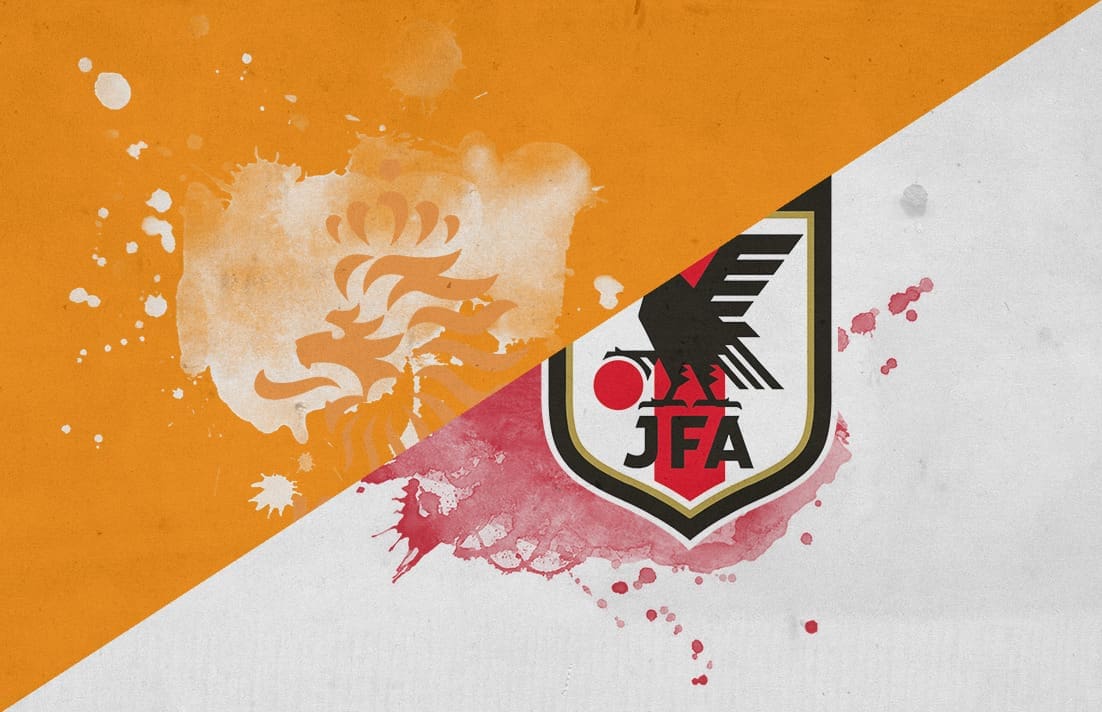


Comments